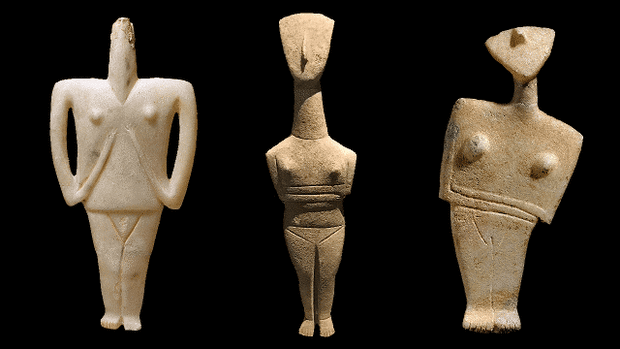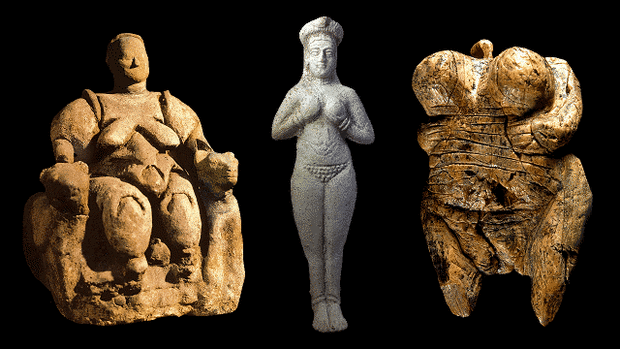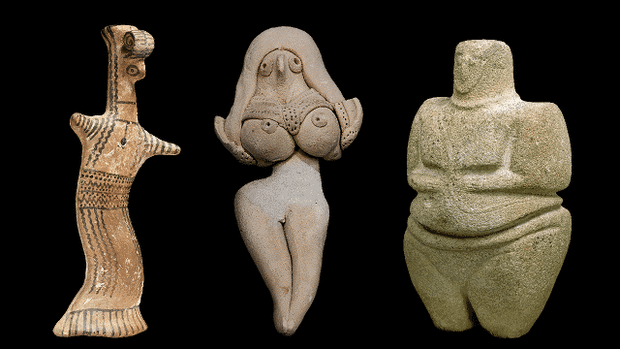Dancing Goddesses: How Nina Paley Animated Stone Sculptures for ‘Seder-Masochism’
We’ve been grooving all summer with the Pointer Sisters and Paley’s animated stone goddesses dancing to the infectious “You Gotta Believe” by Norman Whitfield — now let’s see how they were made.

One of the year’s most engaging indie animated features, Nina Paley’s Seder-Masochism takes audiences on a wild ride through the traditional Passover Seder, with a splendid cornucopia of rich 2D animation set to musical themes ranging from liturgical to pop.
The second feature film from the Central Illinois-based independent animator, who released Sita Sings the Blues in 2009, Seder-Masochism loosely follows a traditional Passover Seder, with events from the Book of Exodus retold by Moses, Aharon, the Angel of Death, Jesus, and the director’s own father. But the film also presents another side of this ancient story: that of the Goddess, humankind’s original deity, in a tragic struggle against the forces of Patriarchy.
Besides being the biblical epic you can dance to, Seder-Masochism is a beautifully crafted and entertaining film, neatly laying out Paley’s interpretation of Exodus. It was selected to compete at this year’s Annecy festival, in June, as well as Poland’s ANIMATOR festival, where it won the feature film audience award. As the film continues its rounds, festival-goers can expect to see it at the upcoming Ottawa and Vancouver festivals, as well as the Animation Is Film festival in Los Angeles.
In a colorful, beautifully designed film that masterfully communicates its message, some of Seder-Masochism’s standout sequences feature dancing stone goddesses dancing to Norman Whitfield’s infectious “You Gotta Believe” as performed by the Pointer Sisters. Put this video on repeat, because you’re not going to be able to tear your eyes away.
The genesis of Paley’s dancing stone goddesses, which deliver lifelike performances that almost appear to be rendered in CG animation, came from an early screening of the as-yet unfinished film. “I showed a rough cut of Seder-Masochism to friends last fall and the main feedback was: MOAR GODDESS,” Paley recounts. “I’d already animated the opening ‘God-Mother’ number, but that wasn’t enough. So I started re-drawing the Egyptian and Mesopotamian goddesses I’d made in Flash 8, to use in Moho Pro, and it was tedious. I wondered, ‘why am I drawing these anyway? Why don’t I use the photo images they’re based on?’ So I hunted for high resolution photos of ancient and prehistoric goddess figures, manually removed backgrounds in GIMP, and rigged and animated them in Moho. It worked very well, so I kept going until I had a large enough collection to make new scenes.”
 Once she had the idea, Paley says, it only took a couple of weeks to gather, prep, rig, and make a basic animation of all the goddesses. “I shared GIFs online as I went, and the feedback was positive, which was a cheerful motivator,” she notes.
Once she had the idea, Paley says, it only took a couple of weeks to gather, prep, rig, and make a basic animation of all the goddesses. “I shared GIFs online as I went, and the feedback was positive, which was a cheerful motivator,” she notes.
Choosing the music for the new Goddess scenes was difficult. “There just aren’t a lot of popular songs from a goddess-y point of view,” Paley observes. “I commissioned a new song from rock musician and Sita Sings the Blues collaborator Todd Michaelsen, but I didn’t end up using it. I prefer songs that have a different original meaning, that the animation gives a second meaning to; when I commission new music it’s just all the same meaning, and the resulting film lacks depth.”
Eventually Paley settled on “You Gotta Believe,” which originally appeared in the movie Car Wash. “’Believe’ in its original context meant something social; the song urged activist men to stand up for their activist Sisters,” Paley remarks. “In Seder-Masochism ‘believe’ takes on religious meaning, referring to pre-Abrahamic goddess worship.”
For Paley, on the main challenges of animating to music is that the beats of most songs don’t fall neatly into a consistent frame rate. “I work at 24fps, so beats every four, six, eight, nine, or 12 frames are ideal,” she explains. “But what usually happens is beats fall every 7.3 frames or something odd like that, and I have to add or skip frames every few cycles to keep things more or less in synch. I know I could speed up or slow down the music, but I’m a purist.”
The “CG” look, according to Paley, is purely incidental. “Moho’s mesh warping abilities are amazing,” she comments, before moving on to outline her workflow using the open-source photo editing softwawre GIMP. “I’ll open an image, usually a JPEG, in GIMP, copy it onto a new layer in a new file with a transparent background, crop it to remove extraneous pixels, and put a layer of white behind it if the background is dark, or black if the background is light,” she describes. “Then I use the ‘eraser’ brush to manually draw along the edges. I size the brush up or down depending on whether I’m going along long, smooth edges, or complicated details. Once I’ve gone around the edge of my figure I enlarge the brush and wipe out the rest of the background. I re-crop a little closer, hide the solid white or black background layer, and export as transparent PNG.”
The resulting PNG file is imported into Moho Pro, where Paley begins rigging “bones,” making what she calls a “little skeleton” to map onto the image. The bones can then be animated with keyframes, distorting the image as they move:

To animate eyeblinks on the Snake Dancer, Paley created a “smart warp” layer, another Moho Pro feature that allows points and edges to be assigned to specific parts of a raster. Then she animated the points, as illustrated in the images below. “You can see the points around the eyes; I just brought these points down onto each other, and voila, blink,” Paley explains.

“Moho lets you combine both smart warp layers and bone layers, as I did on the Snake Dancer and many other figures. Elsewhere in Seder-Masochism I got very precise with warping animation, using it to make characters smile and frown, and otherwise distort raster faces,” she notes.

“Moho permits as many layers as you want,” Paley continues. “It handles both native vectors and raster images, and as long as the PNGs have transparent backgrounds you can see the layers below them. You can also group layers together, and group groups of layers. Layers in Moho are vaguely analogous to Flash’s ‘Symbols,’ except not really, because the programs are drastically different, in spite of both doing 2D vector animation.”
While Paley is enthusiastic about Moho Pro’s capabilities, she acknowledges that the it took time to learn to use the software comfortably wasn’t trivial. “Moho was so different from Flash it took me a couple years to become fluent enough to do anything useful with it,” she recalls. “My first Moho teacher — it was still called Anime Studio Pro then — was Victor Paredes, a brilliant Chilean animator who now works at Cartoon Saloon. He made it look so easy, but it wasn’t for me! He actually visited me in Illinois in 2014 to give me lessons for a week. I didn’t really start expressing myself with Moho until 2017. I did a lot of tests and experiments before then, but I was clumsy. I finally have the hang of Moho, I think. I do not want to go through this difficult learning period again for new software,” she says, adding: “I still love Macromedia Flash 8, and keep an old 2007 Mac Tower around just to use it from time to time.”
Al the compositing for the film was also completed in Moho Pro. “To test parts of animation without rendering everything, I just turn off some layers while I work,” Paley recounts. “Or I animate pieces in different files, and when I’m ready, import everything into a single, absurdly complex and memory-intensive file. I generate hundreds of low-resolution test movies when I’m animating. Once everything’s OK, I render out at 4K — 3840 x 2160 — which can take a long time.”
For editing, Paley employed a mix of Final Cut 5 and Final Cut X. “I edited the whole movie in Final Cut: old Final Cut Pro on my 2007 Mac, and horrible Final Cut Pro X on my new Mac. FCPX’s user interface changes are a disgrace, but I must admit the crunching it can do is impressive, so it was worth learning the horrible new interface so I could edit in 4K,” she relates.
“Fun fact,” she concludes, “Both Final Cut Pro and Flash were originally created by the now-defunct Macromedia before they were bought and worsened by larger corporations, making me think Macromedia was the best software company that ever existed.”
Learn more about the making of Seder-Masochism on Paley’s blog (including the identity of the mysterious Producer X, 24 downloadable goddess GIFs, and trailers and clips). Want more? Try to resist some of the sweet merch available here and here.










![]() Jennifer Wolfe is Editor-in-Chief of Animation World Network.
Jennifer Wolfe is Editor-in-Chief of Animation World Network.

熱門頭條新聞
- China’s Minidramas Make Big Splash
- DevGAMM Lisbon 2024 celebrates another successful edition with more than 750 attendees from around the world
- Wait What’s That – A VRy Unique Take On A Classic Drawing Game – Out Now For Free On Meta Quest!
- Slow-Motion Collapse: How Nostalgia, Streaming, and Short-Sightedness Undermined Hollywood’s Future
- PBS NOVA / GBH JOINS THE PRODUCTION OF ZED AND ARTE’S PREMIUM DOCUMENTARY THE LOST TOMBS OF NOTRE-DAME
- Biopunk Action Title Sonokuni Launching Early 2025
- LifeAfter Season 7 “The Heronville Mystery” Brings a Brand New Folklore Horror Theme for a Unique Survival Experience
- 2024 Developer Showcase and look ahead to 2025
